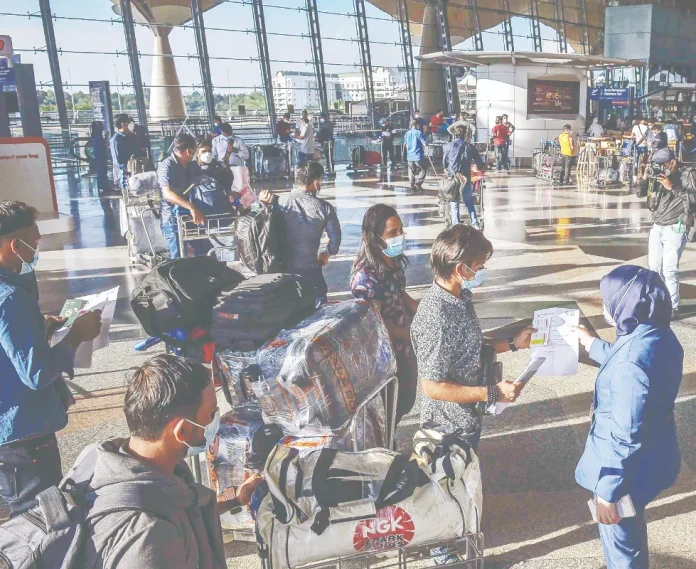KLIA leak highlights deeper oversight failures, raising concerns over MAHB’s safety, supervision and infrastructure governance.
THE viral video of water cascading through the ceiling of KLIA Terminal 1 – less a leak” and more a sudden, unwanted water feature – initially had the bizarre look of fake news. Unfortunately, the swift confirmation by Malaysia Airports Holdings Bhd (MAHB) was all too real.
While the MAHB report quickly pointed the finger at the roofing contractor for an “unacceptable lapse” in leaving plywood safety covers over drainage points, this attribution – factually accurate regarding the immediate cause – feels like a strategic dilution of institutional accountability.
KLIA, as the premier gateway into Malaysia, is a vital national asset. Its reputation must not be allowed to erode through repeated incidents – whether water leaks, recurring Aerotrain failures or past power outages.
ALSO READ: KLIA Terminal 1 water leak caused by contractor error during roof works
Blaming the contractor is easy but it obscures a fundamental truth about managing critical infrastructure: the ultimate responsibility for oversight rests with the owner and operator.
MAHB’s statement positions the incident as a failure of a specific team during a scheduled maintenance and upgrade project, a narrative that neatly frames the event as a minor, isolated procedural slip during an overall positive “infrastructure renewal plan”.
While decisive action against the contractor is necessary, this response fails to address the deeper systemic and supervisory weaknesses that allowed the lapse to occur.
The finding that workers failed to remove plywood used to cover drainage for safety reasons during a sudden storm evacuation is alarming, pointing directly to a failure in the project’s Hazard Identification, Risk Assessment and Risk Control process.
For instance, questions must be raised about the initial risk assessment: Was the procedure of using plywood to seal off critical drainage points during working hours adequately assessed?
In a high-consequence environment like an international airport, the risk of blocking essential water run-off, especially with known high-intensity weather, must surely outweigh the temporary safety benefit of sealing a hole, suggesting that safer, more temporary or non-obstructive safety measures should be considered.
Furthermore, when a lightning warning mandates an emergency evacuation from the rooftop, a critical checkpoint must be the integrity of all temporary protective measures, especially drainage. This procedural failure is not just the contractor’s; it highlights a failure in the MAHB-mandated and supervised work permit system and safety protocols.
The approach to all maintenance work in a critical facility like KLIA must adopt a zero-tolerance mindset for foreign object debris.
Procedures must be treated with the same meticulousness and rigour as work on an aviation engine, where a simple leftover screw can have catastrophic implications.
In this case, the leftover plywood served as a catastrophic blockage, a reminder that a lapse in seemingly minor standard operating procedures can lead to major operational disruption and reputational damage.
Crucially, the core issue is the lack of independent, high-consequence verification. The best industry practice, often applied in the oil and gas sector, is “trust but verify”.
For work in a critical area that can directly impact operations and national reputation, safety cannot be left entirely in the hands of the contractor.
This raises the question of where the independent quality and safety checks by MAHB’s project team were, and where the site supervision was whose duty it was to ensure the immediate environment was secured before the team departed the area.
Beyond the immediate work site, given that KLIA is a highly sensitive and secure area, this incident serves as a valuable lesson to reassess the standards for contractor competency and background checks.
While not the direct cause of the leak, ensuring that all personnel accessing critical zones have the necessary expertise and a thoroughly vetted background is a foundational security measure.
High operational standards require equally high standards for the partners entrusted with maintenance. This incident comes on the heels of other highly publicised operational hiccups – from the Aerotrain’s repeated disruptions to power issues. Each event chips away at the nation’s image.
Visitors’ first and last impression of Malaysia is KLIA, and a video of a leaking ceiling suggests a lapse in the fundamental upkeep expected of a modern international hub.
The true accountability lies not merely in punishing the worker who left the plywood but in the leadership ensuring that the systems, procedures and oversight mechanisms – the very fabric of the airport’s operational integrity – are robust enough to prevent such “unacceptable lapses” in the first place.
MAHB must be transparent about the systemic checks they will implement, not just concerning contractor procedures, but also within their own supervision and validation processes.
Only by adopting a rigorous, “trust but verify” approach to all high-risk, high-consequence work can MAHB begin to repair the reputational damage and ensure that the KLIA gateway reflects the professionalism and high standards the nation deserves.
Comments: [email protected]







